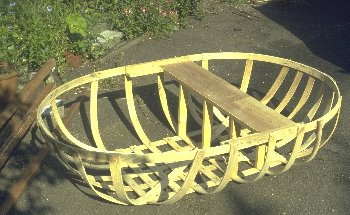
Maybe there's a problem here somewhere? ........
Why had the lengthwise laths bent okay, but not the crosswise ones?
They were from different batches from the sawmill, probably different
trees. I'd already discarded many of the 7ft. laths due to obvious
knots and defects which clearly wouldn't bend, but the ones that had
broken looked superficially okay.
I looked with a more sceptical eye at the broken laths and the remainder
of my 7ft. stock. It started to become clear what the real problem was.
A bad workman blames his tools, they say. Well, in this case I was
only using my hands, and while I certainly can't claim any degree
of experience or proficiency in the work I was trying to do, it was
now clear to me that the wood was most definitely to blame here.
The 7ft. laths were absolutely full of knots and discontinuities in
the grain, unlike the 10ft. ones which were noticeably better, though
by no means all perfect. It was the subtle discontinuities that had
caused the breaks that I'd had so far.
I looked carefully through all the laths, one by one, sorting them into
two piles: usable for bending and unusable (or only for flat flooring).
The 'unusable' pile was growing rather more quickly than the other one.
When I had finished, I only had about ten short laths (out of nearly
fifty) and a moderate number of longer ones - enough to finish the
coracle, but nowhere near enough to make a second or third as I'd
expected with the quantity I'd bought.
I put that problem to one side for the moment, and carried on the
construction using the good laths. By and large, now that I had an
'eye' for what was good or bad, I could adjust the position of the
lath so that the bends were in a strong section, and the laths were
added fairly successfully.
Boiling water from the kettle seemed to be an adequate technique,
if a little messy. Quite soon, the floor of the garage was very wet.
In the absence of any help from the family, I found that bungee
straps were most effective in putting gentle tension on a lath
during bending, and helped minimise BFS (boiled finger syndrome)!
Once or twice, a weak spot appeared to develop in a lath while
drying, so I'd bind a second short bit on the outside of the bend
as a stiffener/strengthener while it dried. It seemed to work
alright, as once dried into a good curve, they were very strong.
 |
Within about a week of putting the odd lath in here and there, the frame was finished. It was really starting to look like a coracle now. I didn't get round to weighing it at that stage, but it felt incredibly light. It didn't seem reasonable that it would take an adult's weight. |
| The finished frame, sanded and ready for covering once dry |